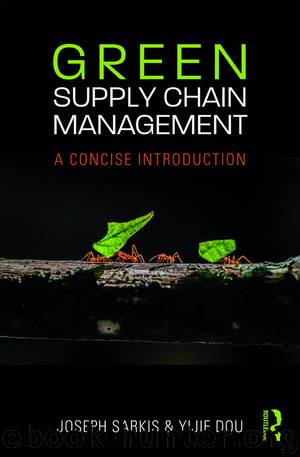Green Supply Chain Management by Sarkis Joseph Dou Yijie & Yijie Dou

Author:Sarkis, Joseph,Dou, Yijie & Yijie Dou
Language: eng
Format: epub
Publisher: Taylor & Francis (CAM)
5
Green Logistics and Transportation
The term logistics and transportation refers to the movement and storage of products and materials along the supply chain. Globalization, overviewed in Chapter 7, has influenced logistics and transportation in the areas of economic development and environmental sustainability (Fahimnia et al., 2015). Over the past 30 years, international investment and trade have grown rapidly. The value of international exports has increased from US$1.986 trillion in 1980 to US$12.486 trillion in 2015 (The World Bank, 2017). Economic globalization has prompted companies to adopt demand-driven sales planning and JIT (just-in-time) inventory, characterized by quick changeovers and small lot size order practices. Speed-to-market distribution is regarded as a necessity for achieving international competitiveness. JIT inventory and delivery management has been used by multinational companies to lower the logistics cost and to improve their supply chain management efficiency. Economic globalization, outsourcing, and offshoring, along with other subsequent organizational responses with various practices, such as JIT and lean management practices, have significantly driven the expansion of logistics and transportation services.
Increasing logistics services have intensified the environmental impacts of transportation activities (Rondinelli and Berry, 2000). For example, transportation plays a role in climate change, and it is estimated that 15 percent of global CO2 emissions are from the transportation sector (Rodrigue et al., 2013). In the United States, the transportation sector is responsible for over 50 percent of NOx total emissions inventory, over 30 percent of VOCs (volatile organic compounds) emissions, and over 20 percent of PM (particulate matter) emissions (EPA, 2017).
Green logistics applies environmental principles and seeks to manage the environmental burden of all stages of traditional logistics systems—product design, material sourcing, manufacturing processes, delivery of the final product to the consumers, after sales, product return, remanufacturing/reuse, and recycling. Green logistics objectives can be analyzed from two aspects (Fahimnia et al., 2015): (1) At the strategic level, green logistics objectives are the selection of green logistics providers, green transport fleets, and green distribution strategies. (2) At the operational level, green logistics focuses on the issues of green routing, delivery scheduling, and efficient inventory management. A wide variety of green logistics aspects, such as choice of electronic vehicles and fuels, green intelligent transportation systems, green infrastructure, green air and water/maritime transportation, and environmental assessment of transportation, can be found in the literature.
Green logistics may include forward logistics and reverse logistics. This chapter mainly focuses on forward logistics and the transportation activities of logistics. In order to give a concise introduction of green logistics, this chapter seeks to introduce the following items:
Definitions of green logistics
The critical drivers of green logistics
Environmental impacts of transportation and logistics
Environmental impacts of other logistics activities
Green transportation and logistics practices
Logistics environmental issues and improvements
Download
This site does not store any files on its server. We only index and link to content provided by other sites. Please contact the content providers to delete copyright contents if any and email us, we'll remove relevant links or contents immediately.
Life 3.0: Being Human in the Age of Artificial Intelligence by Tegmark Max(5395)
The Sports Rules Book by Human Kinetics(4204)
The Age of Surveillance Capitalism by Shoshana Zuboff(4108)
ACT Math For Dummies by Zegarelli Mark(3927)
Unlabel: Selling You Without Selling Out by Marc Ecko(3549)
Blood, Sweat, and Pixels by Jason Schreier(3528)
Hidden Persuasion: 33 psychological influence techniques in advertising by Marc Andrews & Matthijs van Leeuwen & Rick van Baaren(3409)
The Pixar Touch by David A. Price(3325)
Urban Outlaw by Magnus Walker(3298)
Bad Pharma by Ben Goldacre(3199)
Project Animal Farm: An Accidental Journey into the Secret World of Farming and the Truth About Our Food by Sonia Faruqi(3134)
Kitchen confidential by Anthony Bourdain(2962)
Brotopia by Emily Chang(2941)
Slugfest by Reed Tucker(2892)
The Content Trap by Bharat Anand(2831)
The Airbnb Story by Leigh Gallagher(2747)
Coffee for One by KJ Fallon(2513)
Smuggler's Cove: Exotic Cocktails, Rum, and the Cult of Tiki by Martin Cate & Rebecca Cate(2420)
Beer is proof God loves us by Charles W. Bamforth(2337)
